Weaponry
Weapon |
Range / Mass |
Description |
Type I Personal Phaser ("Cricket")
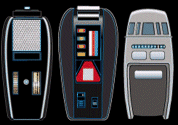 |
50 Meters 1/2 KG |
Small, hand-held, very easily concealed.
Characterized by its wafer-thin styling, the Type I Phaser is less than 10 centimeters
long 5 centimeters wide, and 3 centimeters thick. Inside this slim housing are two
power converter chips that can be recharged from a portable energy packs or from an
adaptable connector on standard tricorders, it is capable of settings 1-8 and can
discharge up to 15 KJ of energy in 2 second bursts. Unique to this design is the
hand-print security coding, which makes each weapon responsive only to a single set of
fingerprints. This surface plate of Type I Phaser contains two pressure- sensitive
energy regulators: the left-hand activator controls non-lethal energy discharges and
the right-hand plate deals with more destructive energies. In normal use, the user
selects the amount of energy to be released from the appropriate activator by the amount
of finger pressure on the proper plate, thus eliminating the need to adjust settings at a
critical moment. |
Type II Personal Phaser
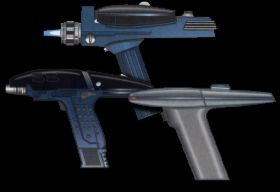 |
75 Meters 1 KG |
A heavier Phaser with a stronger power source for more range. It's dimensions
are 22 CM long, 7 CM wide by 16 CM thick, and is usually worn in a hip-holster that
doubles as a recharging unit. The Type II combines two interlocking phased-particle
beams in collimator field to produce a single-charged particle beam. The resulting
firepower is far greater than earlier models, and is capable levles 1-16 and can penetrate
the strongest alloy or reflective defensive armor at close range. By altering the
frequency of the beam’s dispersal pattern, the Type II power collimator can also
reduce the electron flow, generating a simple laser or a variety of plasma like beams
suitable for non-combat emergencies when communications or energy transmission are
required. |
Type IIa
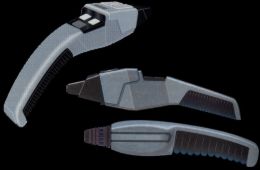 |
75 Meters 1 KG |
This upgraded version of the Type II became standard issue in 2360, and has all but
replaced the original model. It's dimensions are 22 CM long, 9 CM wide and 6 CM
thick. This phaser is mountable to the arm of the standard Security body armor and
can be fired through the suit's control system. Sensors prevent the phaser to be
fired while the hand is in the way of the beam or ungloved. Otherwise if functions
like the normal Type II Phaser above. Both are capable of producing 1.55 X 10J of
energy in .25 second bursts. |
Type III Phaser Rifle (standard)
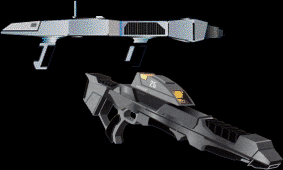 |
250 Meters 5 KG |
The Type III Phaser Rifle was designed for use by Federation Security and Marine
detachments in prolonged combat conditions against heavily armed opponents. Standing
83 CM in length, 13 CM wide, and 22 CM thick with extended power packs in the
weapon’s duralloy stocks. Extended focusing apparatus along the barrel permit
pinpoint accuracy with the high-energy beam. Separate attachments for data links to
tricorders allow the use of several computer-enchanced optical aids, an early-warning
system, improved fire-control, and automatic tracking.
Power output is similar to the Type II phaser but for longer duration bursts. |
Type III-(A through C)
Compression Phaser Rifle
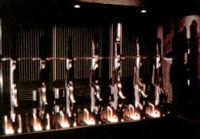
There are three versions. Listed below. |
120 Meters - 500 Meters 2.2 KG -
6.9 KG |
The much larger and heavier Type III-(A through D) Compression Phaser Rifles were
introduced to combat the arrival of the Borg. It has similar features of the
Type III Phaser Rifle except its beam is more focused, capable of inflicting damage
much quicker and a larger power pack capacity. During the start of the Dominion war,
the Compression Phaser Rifles gave the Federation forces much needed firepower.
It is a pulsed phaser fed from two class II power cells. Due to the additional power
drain that comes with pulsed phaser fire, this weapon has twice the energy demand of a
type II weapon while offering 120% impact on unshielded targets. The advantage is
the ability to wear down shielding at 250% rate of the linear model and the better short
range coverage compared to type II phaser. When attached to a stable frame, a photon
grenade launcher can be mounted.
After Starfleet’s initial encounters with the Borg it becomes clear that in order to
prove effective against all species the phaser will have to be adjusted. All models
of phaser rifle in use in 2373 can be programmed to automatically alter the frequency of
the beam, making it harder for an opponent to generate effective shields. |
Version A:
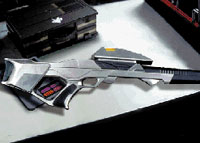 |
120 Meters
(launcher 60M) 2.2 KG
(launcher +1.1KG) |
This is the standard model found aboard most ships, and is used more frequently than
the preceding models. It is constructed of light weight material and can be carried
in one hand. Some models, have a single grip. For accuracy in aiming, the user
can support the barrel with his or her free hand without danger. |
Version B: |
250 Meters
(60 with
diffuser) 2.8 KG
(3 with
diffuser) |
This model features a double-handed grip that is similar to that of its immediate
predecessor. Provides ample linear phaser power at short to medium range and little
weight. A good choice in rougher terrain and urban environment. When equipped
with an energy diffusor the weapon is equivalent to a shotgun, making for an excellent
choice in narrow vicinities with the demand for quick firepower to cover a large area at
short range. Drawbacks are the short target range and the amount of waste heat the
diffuser system produces. |
Version C: |
500 Meters 6.9KG +
frame 8.6KG |
Type C is a pulsed phaser fed from a class III multiple pack power unit in a backpack
or through umbilicial feed from a vehicle or mobile generator, and is the weapon of a
dedicated and especially trained gunner, providing the heavy firepower for the
squad. It can either be mounted in a body suspension frame worn by the gunner for
mobile use, vehicle mounted or put down on the attachable bipod. |
| Stun Grenade |
Varies
(throwing range or 60 M with launcher) 1/2 KG |
Like phaser weapons, the Stun Grenade has a light, medium and heavy stun settings with
the same effects. The blast range of a detonating grenade is roughly 10
meters. Other settings includes, detonating on impact, or up to a 30 second delay or
by target approximately. |
| Concussion Grenade |
Varies
(throwing range or 60 M with launcher) 1/2 KG |
A much more lethal grenade. It can be set from a loud noise maker that can
disorient a target or powerful enough to blast a hole through a medium alloy or ceramic
structure nearly 30 cm thick. Its effective range at maximum strength is 25 meters,
any organic humanoids caught within its blast range is lethal. Other settings
includes, detonating on impact, or up to a 30 second delay or by target approximately. |
| Tangler Grenade |
Varies
(throwing range or 60 M with launcher) 1/2 KG |
An exploding tangler grenade throws out hundreds of strong, sticky polymer
threads. These threads stick to everything within a 3 meter radius. An
entangled individual can not move until the threads decay (in 30 minutes) until solvaway
is spread over the threads. |
| Anti-Matter Grenade Launcher |
550 Meters - 4 KM 10 KG |
The Anti-Matter Grenade Launcher delivers a less powerful blast than the Photon
Cannon, but it is still lethal enough and can cover a wide area. With its 300-degree
arc of fire and range of 550 meters to 4 kilometers, the launcher is a good supplement of
the Photon Cannon when ground-base Security teams are under attack or wish to provide fire
support. A single grenade contains 2.8 grams of anti-matter, capable of destroying
or immobilizing targets within its firing arc and range. |
| Phaser Cannon |
10 KM 10 KG |
The Model IV shoulder or tripod mounted Phaser Cannon, is the latest in the
ground-to-air defence. The targeting and tracking computer is very reliable, that
the user only has to aim at the target they wish to shoot at and wait for the computer to
lock onto it then pull the trigger. The Phaser Cannon at extreme range can hit ships
in low orbit from the planet's surface and is also capable at maximum power of knocking
down large assault shuttles and atmospheric fighters. However its power packs can
supply only 5 shots at full power before needing to be replaced. The Phaser Cannon
has no stun settings. |
| Photon Cannon |
2 KM 20 KG |
To protect members of an Away Team from hostile indigenous populations or to abort a
close assault on a ground installation, Security can use one of several Photon
Cannons. The Photon Cannon is a short range, but incredibly destructive, weapon
descended from laser and phaser projectors. Once the cannon is beamed down, it can
maneuver on a self-propelled platform. It has access to virtually limitless power
from the command ship’s microwave relay projectors to accelerate high-energy
anti-photons in a magnetic chamber. When the cannon is fired, the stream of charged
particles is powerful enough to penetrate the heaviest armor or energy-screen
defences. Because of short halflife of the rapidly decaying anti-photons, the Photon
Cannon’s range is limited to two kilometers. This is sufficient to meet most
ground threats. |







